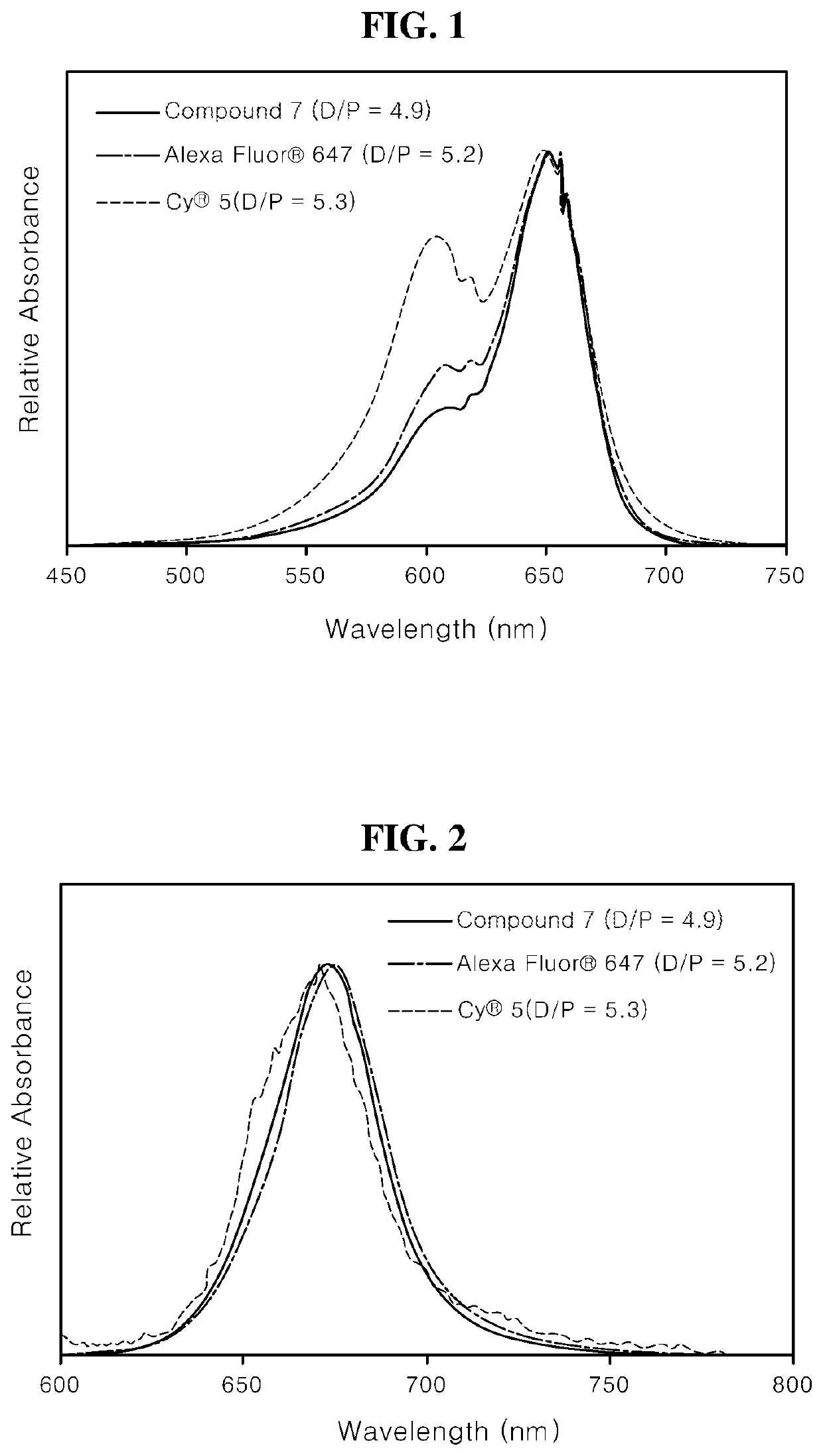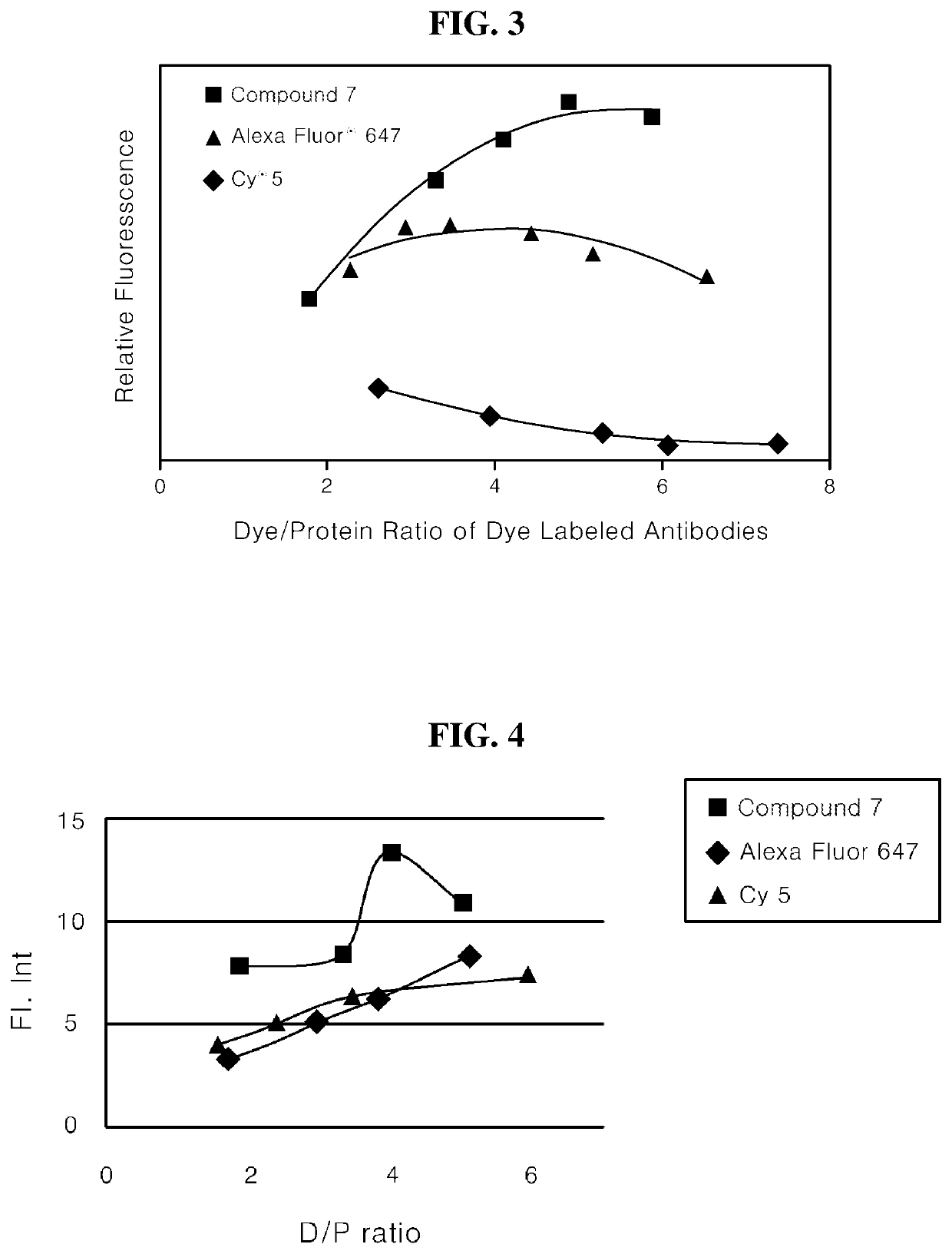Labeling dye and kit including same
- Summary
- Abstract
- Description
- Claims
- Application Information
AI Technical Summary
Benefits of technology
Problems solved by technology
Method used
Image
Examples
preparation examples
1) Preparation of [Compound 7]
[0107]
[0108]7.7 g of ammonium 2-aminoethane-1,1-disulfonic acid hydrate, 12.1 g of Intermediate 1 (WO 2003 / 074091 A2), 8.0 g of 1-(3-dimethylaminopropyl)-3-ethylcarbodiimide hydrochloride (EDC hydrochloride), and 5.6 g of 1-hydroxybenzotriazole (HOBt) were introduced into 77 ml of dimethylformamide (DMF), and the resulting mixture was stirred at room temperature for 24 hours. Thereafter, the product was concentrated under reduced pressure and a solid was precipitated with ethylene acetate. The precipitated solid was filtered and vacuum dried to prepare Intermediate 2 (4.0 g, 21.6%).
[0109]Intermediate 2 (4.0 g) and 1.9 g of malonaldehyde dianilide hydrochloride were introduced into a reactor, and 20 ml of each of acetic acid and acetic anhydride were added thereto, and then the resulting mixture was refluxed at 110° C. and stirred for 6 hours. Thereafter, after cooling, the product was concentrated under reduced pressure, and a solid was precipitated wit...
experimental examples
Experimental Example 1
[0139]The photophysical properties of [Compound 7] obtained in the Preparation Examples were evaluated, and the results are shown in [Table 1]. The maximum absorption wavelength λabs, max), the maximum fluorescence wavelength (λPL, max), the molar extinction coefficient (ε at λmax), and the quantum efficiency (Φ) were measured for each solvent. The measurement was performed in DMSO, ethanol (EtOH), methylene chloride (MC), water, and PBS, and the measurement results are shown in the following Table 1.
TABLE 1ClassificationDMSOEtOHMCWaterPBSλabs, max / 656 / 656 / 666 / 650 / 650 / ε at λmax201,000232,000155,000227,000230,000λPL, max / 685 / 682 / 685 / 670 / 669 / Φ 0.623 0.483— 0.261 0.315
[0140]As shown in [Table 1], it can be confirmed that [Compound 7] of the present invention is dissolved in various solvents to show high extinction coefficients.
experimental example 2
[0141]After a 1 mg / ml protein solution was prepared by diluting Goat Anti-Mouse IgG with a 0.1 M sodium bicarbonate buffer, 125 μl of the protein solution was added to each of 5 tubes. A dye solution (5 mg / ml) including prepared Compound 7 was added to prepared tubes at 1, 2, 3, 4, and 5 μl, and the tubes were immediately vortexed. Subsequently, after the dye solutions were shaken at room temperature in a locker for 30 minutes, the reaction solutions were added to Amicon centrifuge filters. The reaction solutions were filtered with PBS until the free dye was removed by a centrifuge (14,000 rpm, 10 minutes, 5 times).
[0142]After inverting and binding the centrifuge filter to an Amicon tube, the filtrate was recovered (1000 rpm, 2 minutes) and then diluted with 1 ml of PBS, and then fluorescence was measured by UV, PL and a microplate reader.
[0143]The ratio of the dye to the protein was determined using the following equation.
DP=Adye×Eprot(A280-XAdye)×Edye
[0144]Adye: Absorbance of dye ...
PUM
 Login to View More
Login to View More Abstract
Description
Claims
Application Information
 Login to View More
Login to View More - R&D
- Intellectual Property
- Life Sciences
- Materials
- Tech Scout
- Unparalleled Data Quality
- Higher Quality Content
- 60% Fewer Hallucinations
Browse by: Latest US Patents, China's latest patents, Technical Efficacy Thesaurus, Application Domain, Technology Topic, Popular Technical Reports.
© 2025 PatSnap. All rights reserved.Legal|Privacy policy|Modern Slavery Act Transparency Statement|Sitemap|About US| Contact US: help@patsnap.com



